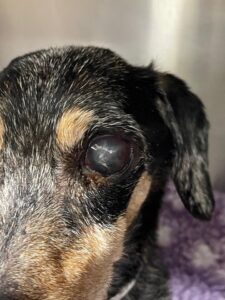
Mount Carmel Animal Hospital near Harford County informs readers about the seriousness of glaucoma in dogs.
Glaucoma is an eye disease in which the pressure within the eye, is known as intraocular pressure (IOP). If your canine displays any signs of this eye disease, a veterinarian should view him or her immediately. Mount Carmel Animal Hospital near Harford County informs readers about the seriousness of glaucoma in dogs.
What Is It?
The eyeball is filled with fluid, known as aqueous humor, that is filled with nutrients and oxygen the eye needs to function properly. As long as the absorption, production, or drainage of aqueous humor is balanced, the intraocular pressure remains consistent. Glaucoma occurs when there is a buildup of aqueous humor that increases eye pressure to unhealthy levels.
Causes
Glaucoma in dogs happens because of inadequate drainage of aqueous fluid. There are two types of glaucoma: primary or secondary glaucoma. Primary glaucoma results are caused by the high intraocular pressure in an otherwise healthy eye. It can occur as a result of genetics, which is why some breeds are more prone than others. Secondary glaucoma occurs due to injury or disease to the eye. This is the most prevalent cause of glaucoma in dogs. Causes may include:
- Tumors may physically block the iridocorneal angle, the structure that allows for the drainage of aqueous humor.
- Uveitis, or inflammation of the inside of the eye, can result in scar tissue and debris blocking the drainage angle.
- A blood clot may prevent drainage of the aqueous humor if there is bleeding in your canine’s eye.
- Damage to the lens can result in swelling and blockage of the drainage angle.
Signs or Symptoms
The most prevalent signs of glaucoma in dogs include:
- Your pet might partially close and rub at the eye, indicating eye pain.
- A watery discharge from your pet’s eye.
- Loss of appetite, lethargy, or unresponsiveness.
- The cornea or clear part of the eye might become bluish or cloudy in color.
- Blindness can develop unless the increased IOP is minimized.
Diagnosis
All of the signs above can happen unexpectedly with acute glaucoma. However, they may develop more slowly in chronic glaucoma. These signs may have been present for some time before your dog showed any discomfort or clinical signs.
Diagnosing glaucoma in dogs depends upon internal eye examination and accurate IOP measurement using special instruments. A quick diagnosis is crucial to avoiding permanent damage to the eye. If your pet is displaying any of the listed symptoms, you should contact us at Mount Carmel Animal Hospital immediately.
Treatment
Minimizing the IOP as quickly as possible is imperative to reduce the risk of blindness and irreversible damage. It’s also essential to treat any underlying disease that might be responsible for the glaucoma in dogs. So, depending on the cause of glaucoma, medication can be used to minimize and manage the condition. In more severe cases or cases where glaucoma is a result of trauma, surgical removal of the eye may be the only option to alleviate your pet’s discomfort.
HERE AT MOUNT CARMEL ANIMAL HOSPITAL, WE’LL TREAT YOUR PETS LIKE FAMILY!
Mount Carmel Animal Hospital has been serving the Northern Baltimore/Southern York community for over 30 years and is proud to be an independently operated, small animal practice committed to excellence in veterinary medicine and client service. From grooming to wellness services, along with Canine Life Skills Training Courses, and surgical procedures, we have the expertise that will best serve the needs of you and your pet. Contact us at 410-343-0200 and follow us on Facebook!
